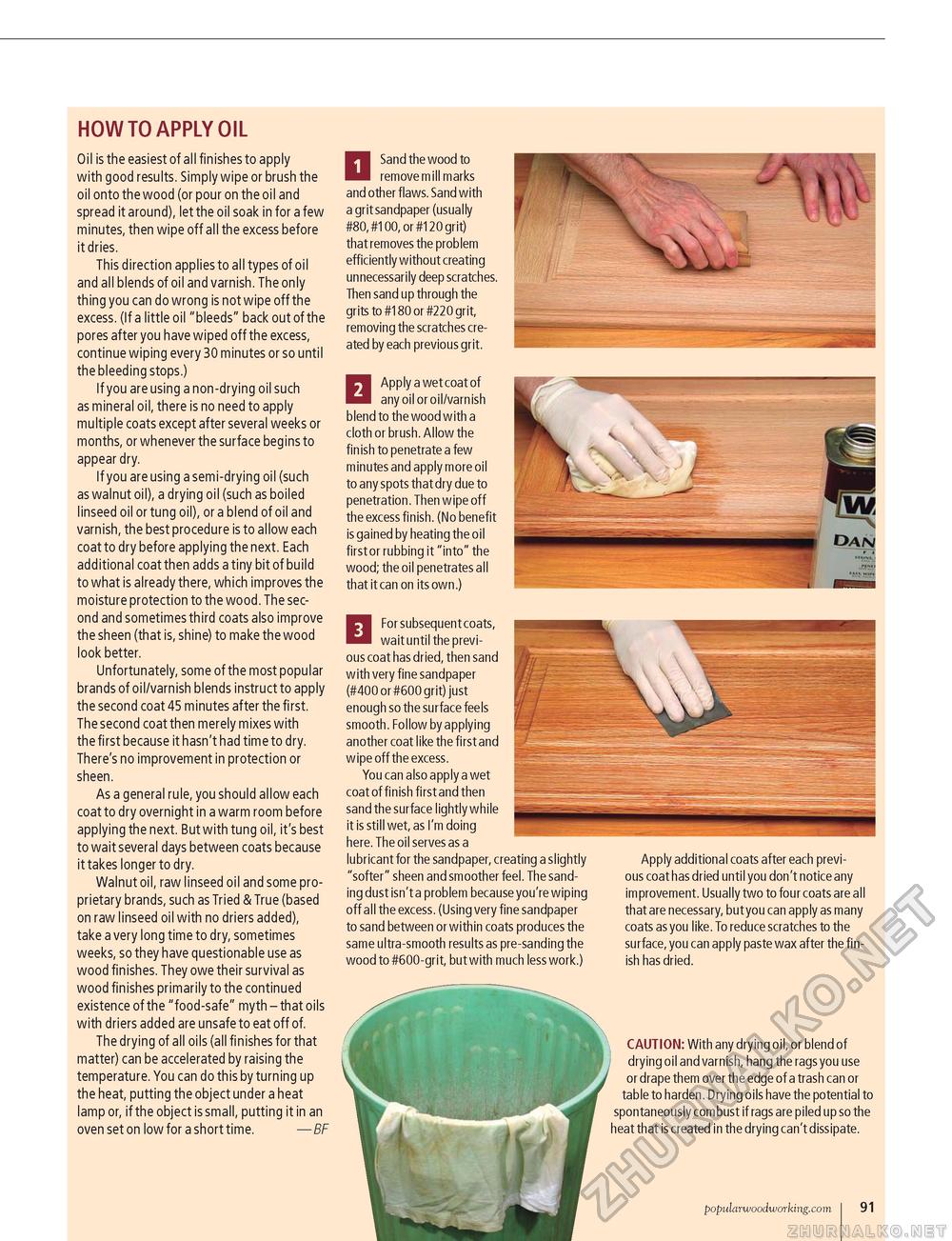Popular Woodworking 2006-04 № 154, страница 94
HOW TO APPLY OIL DSand the wood to remove mill marks and other flaws. Sand with a grit sandpaper (usually #80, #100, or #120 grit) that removes the problem efficiently without creating unnecessarily deep scratches. Then sand up through the grits to #180 or #220 grit, removing the scratches created by each previous grit. □ Apply a wet coat of any oil or oil/varnish blend to the wood with a cloth or brush. Allow the finish to penetrate a few minutes and apply more oil to any spots that dry due to penetration. Then wipe off the excess finish. (No benefit is gained by heating the oil first or rubbing it "into" the wood; the oil penetrates all that it can on its own.) Oil is the easiest of all finishes to apply with good results. Simply wipe or brush the oil onto the wood (or pour on the oil and spread it around), let the oil soak in for a few minutes, then wipe off all the excess before it dries. This direction applies to all types of oil and all blends of oil and varnish. The only thing you can do wrong is not wipe off the excess. (If a little oil "bleeds" back out of the pores after you have wiped off the excess, continue wiping every 30 minutes or so until the bleeding stops.) If you are using a non-drying oil such as mineral oil, there is no need to apply multiple coats except after several weeks or months, or whenever the surface begins to appear dry. If you are using a semi-drying oil (such as walnut oil), a drying oil (such as boiled linseed oil or tung oil), or a blend of oil and varnish, the best procedure is to allow each coat to dry before applying the next. Each additional coat then adds a tiny bit of build to what is already there, which improves the moisture protection to the wood. The second and sometimes third coats also improve the sheen (that is, shine) to make the wood look better. Unfortunately, some of the most popular brands of oil/varnish blends instruct to apply the second coat 45 minutes after the first. The second coat then merely mixes with the first because it hasn't had time to dry. There's no improvement in protection or sheen. As a general rule, you should allow each coat to dry overnight in a warm room before applying the next. But with tung oil, it's best to wait several days between coats because it takes longer to dry. Walnut oil, raw linseed oil and some proprietary brands, such as Tried & True (based on raw linseed oil with no driers added), take a very long time to dry, sometimes weeks, so they have questionable use as wood finishes. They owe their survival as wood finishes primarily to the continued existence of the "food-safe" myth - that oils with driers added are unsafe to eat off of. The drying of all oils (all finishes for that matter) can be accelerated by raising the temperature. You can do this by turning up the heat, putting the object under a heat lamp or, if the object is small, putting it in an oven set on low for a short time. — BF BFor subsequent coats, wait until the previous coat has dried, then sand with very fine sandpaper (#400 or #600 grit) just enough so the surface feels smooth. Follow by applying another coat like the first and wipe off the excess. You can also apply a wet coat of finish first and then sand the surface lightly while it is still wet, as I'm doing here. The oil serves as a lubricant for the sandpaper, creating a slightly "softer" sheen and smoother feel. The sanding dust isn't a problem because you're wiping off all the excess. (Using very fine sandpaper to sand between or within coats produces the same ultra-smooth results as pre-sanding the wood to #600-grit, but with much less work.) Apply additional coats after each previous coat has dried until you don't notice any improvement. Usually two to four coats are all that are necessary, but you can apply as many coats as you like. To reduce scratches to the surface, you can apply paste wax after the finish has dried. CAUTION: With any drying oil, or blend of drying oil and varnish, hang the rags you use or drape them over the edge of a trash can or table to harden. Drying oils have the potential to spontaneously combust if rags are piled up so the heat that is created in the drying can't dissipate. popularwoodworking.com i 91 |








